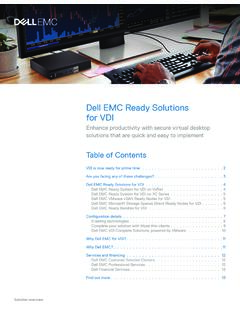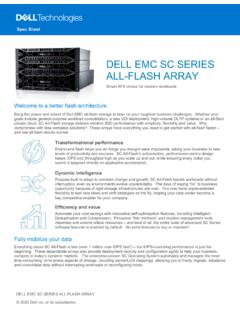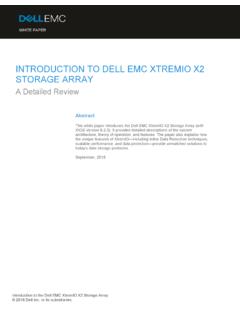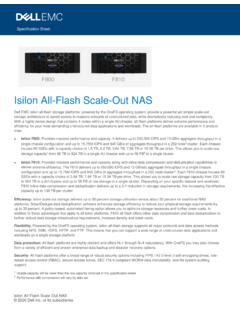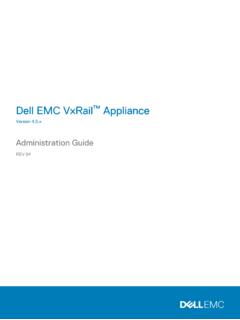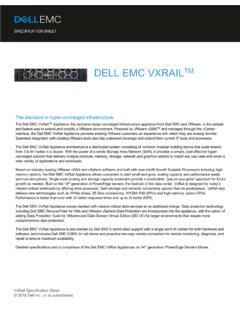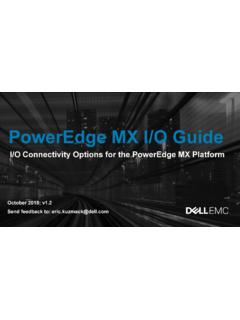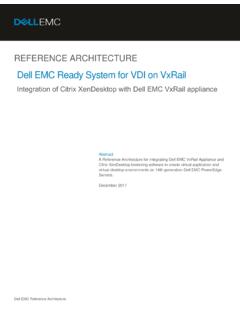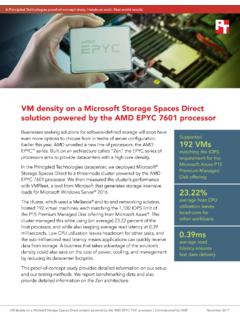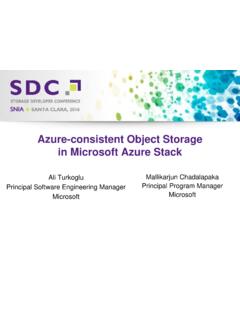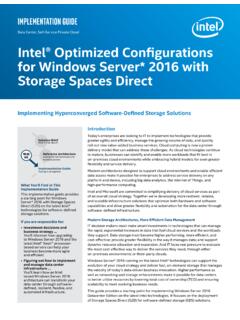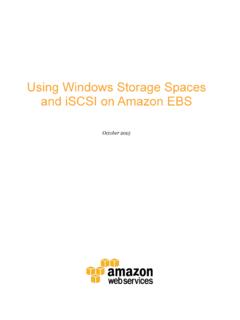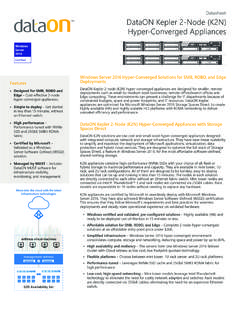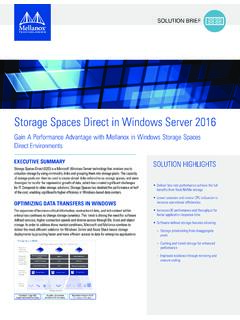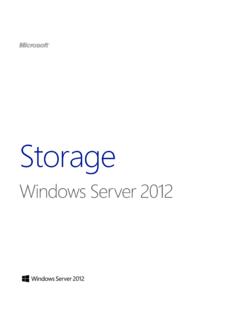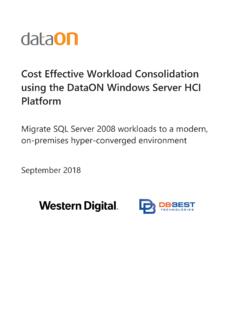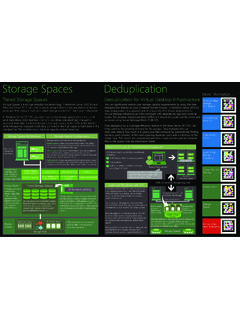Transcription of Dell EMC Storage Spaces Direct (S2D) Ready Nodes for ...
1 A Dell EMC Reference Architecture Dell EMC Storage Spaces Direct (S2D) Ready Nodes for microsoft Remote Desktop Services (RDS) Reference Architecture Integration of microsoft RDS with Dell S2D Ready Node appliance clusters. Dell Engineering October 2017 2 Dell EMC Storage Spaces Direct (S2D) Ready Nodes for microsoft Remote Desktop Services (RDS) Reference Architecture Revisions Date Description October 2017 Initial release The information in this publication is provided as is. Dell Inc. makes no representations or warranties of any kind with respect to the information in this publication, and specifically disclaims implied warranties of merchantability or fitness for a particular purpose. Use, copying, and distribution of any software described in this publication requires an applicable software license. Copyright 2015 2017 Dell Inc.
2 Or its subsidiaries. All Rights Reserved. Dell, EMC, and other trademarks are trademarks of Dell Inc. or its subsidiaries. Other trademarks may be the property of their respective owners. Published in the USA [10/16/2017] [Reference Architecture] Dell believes the information in this document is accurate as of its publication date. The information is subject to change without notice. 3 Dell EMC Storage Spaces Direct (S2D) Ready Nodes for microsoft Remote Desktop Services (RDS) Reference Architecture Table of contents 1 Introduction .. 5 Objective .. 5 2 Solution architecture overview .. 6 Introduction .. 6 Storage Spaces Direct (S2D) overview .. 6 S2D architecture .. 7 Dell EMC S2 DRN hyper-converged infrastructure .. 11 Dell EMC S2 DRN VDI solution architecture .. 12 3 Hardware components .. 14 Network .. 14 VDI optimized Dell EMC S2D Ready Nodes .. 16 Dell Wyse Endpoints.
3 19 4 Software components .. 22 microsoft .. 22 5 Solution architecture for RDS .. 29 Management role configuration .. 29 Storage configuration overview .. 31 Virtual networking .. 33 Scaling guidance .. 34 Solution high availability .. 36 microsoft RDS communication flow .. 37 6 Solution Performance and Testing .. 38 Test and performance analysis methodology .. 38 Test configuration details .. 41 Test results and analysis .. 43 7 Related resources .. 55 Acknowledgements .. 56 About the authors .. 57 4 Dell EMC Storage Spaces Direct (S2D) Ready Nodes for microsoft Remote Desktop Services (RDS) Reference Architecture Executive summary This document provides the reference architecture for integrating Dell EMC microsoft Storage Spaces Direct Ready Nodes (S2D Ready Nodes ) and microsoft Remote Desktop Services (RDS) software to create virtual application and virtual desktop environments.
4 The available S2D Ready Node choices include the latest 14th generation PowerEdge R640 and R740xd servers. The Dell EMC S2D Ready Nodes comprise a hyper-converged solution that combines Storage , compute, networking, and virtualization using industry-proven Dell EMC PowerEdge servers and microsoft Storage Spaces Direct technology provided natively in Windows Server 2016 Datacenter edition. As the foundation for a complete, adaptive IT solution, PowerEdge servers deliver superior agility and reliability, outstanding operational efficiencies and top performance at any scale. With its latest generation of PowerEdge servers, Dell EMC makes server innovations more affordable and accessible, putting more power into the hands of people than ever before. microsoft RDS provides a complete end-to-end virtualization software solution delivering microsoft Windows virtual desktops or server-based hosted shared sessions to users on a wide variety of endpoint devices.
5 5 Dell EMC Storage Spaces Direct (S2D) Ready Nodes for microsoft Remote Desktop Services (RDS) Reference Architecture 1 Introduction This document addresses the architecture design, configuration and implementation considerations for the key components required to deliver virtual desktops or shared sessions via microsoft Remote Desktop Services (RDS) on Windows Server 2016 Hyper-V hypervisor running on the Dell EMC microsoft Storage Spaces Direct Ready Nodes (S2D Ready Nodes ) hyper-converged infrastructure platform. NOTE: For step by step deployment instructions, please refer to the Dell EMC microsoft Storage Spaces Direct Ready Node Deployment Guide located here: LINK Objective Relative to delivering the virtual desktop environment, the objectives of this document are to: Define the detailed technical design for the solution. Define the hardware requirements to support the design.
6 Define the constraints which are relevant to the design. Define relevant risks, issues, assumptions and concessions referencing existing ones where possible. Provide a breakdown of the design into key elements such that the reader receives an incremental or modular explanation of the design. Provide solution scaling and component selection guidance. 6 Dell EMC Storage Spaces Direct (S2D) Ready Nodes for microsoft Remote Desktop Services (RDS) Reference Architecture 2 Solution architecture overview Introduction Dell EMC microsoft Storage Spaces Direct Ready Nodes (S2D Ready Nodes ) combine the Storage Spaces Direct technology included in microsoft Windows Server 2016 Datacenter with industry-leading Dell EMC PowerEdge servers using local drives to create highly available and scalable software-defined Storage at a fraction of the cost of traditional Storage arrays.
7 Dell EMC S2D Ready Nodes are pre-configured with certified components, tested and certified by Dell EMC and microsoft to deliver an outstanding hyper-converged infrastructure for Hyper-V based VDI solutions. Storage Spaces Direct (S2D) overview Storage Spaces Direct (S2D) is the evolution of Storage Spaces , first introduced in Windows Server 2012. It leverages many of the features you know today in Windows Server, such as Failover Clustering, the Cluster Shared Volume (CSV) file system, Server Message Block (SMB) 3, and of course Storage Spaces . It also introduces new technology, most notably the Software Storage Bus and the Resilient File System (ReFS). S2D enables building highly available and scalable Storage using servers with local Storage . Using servers with local Storage decreases complexity, increases flexibility and scalability, as well as enables the use of Storage devices with better performance, such as solid state disks and NVMe disk devices.
8 This was previously not possible with clustered Storage Spaces and shared disks. S2D removes the need for a shared SAS fabric, simplifying deployment and configuration. Instead it uses the network as a Storage fabric, leveraging SMB3 and SMB Direct (RDMA) for high-speed, low-latency CPU efficient Storage . To scale out, simply add more servers to increase Storage capacity and I/O performance. Key benefits of this solution include: Simplicity: Go from running Windows Server 2016 to your first Storage Spaces Direct cluster in under 15 minutes. High Performance: Storage Spaces Direct provides consistent, low latency performance thanks to its hypervisor-embedded architecture, its built-in read/write cache, and support for multiple types of high-speed Storage devices. Fault Tolerance: Built-in resiliency handles drive, server, or component failures with continuous availability.
9 When hardware fails, just swap it out; the software heals itself, with no complicated management steps. Resource Efficiency: Erasure coding delivers up to greater Storage efficiency, with unique innovations like Local Reconstruction Codes and ReFS real-time Storage tiers to extend these gains to hard disk drives and mixed hot/cold workloads, all while minimizing CPU consumption to give resources back to where they're needed most - the VMs. Manageability: Use Storage QoS Controls to keep overly busy VMs in check with minimum and maximum per-VM IOPS limits. The Health Service provides continuous built-in monitoring and alerting, and new APIs make it easy to collect rich, cluster-wide performance and capacity metrics. 7 Dell EMC Storage Spaces Direct (S2D) Ready Nodes for microsoft Remote Desktop Services (RDS) Reference Architecture Scalability: Go up to 16 servers and over 400 drives, for up to 1 petabyte of Storage per cluster.
10 To scale out, simply add drives or add more servers; Storage Spaces Direct will automatically onboard new drives and begin using them. Storage efficiency and performance improve predictably at scale. S2D can be configured in a converged (also known as disaggregated) deployment option or as a hyper-converged deployment option. The converged option layers in Scale-out File Servers to provide network-attached Storage over SMB3 file shares whereas the hyper-converged option runs Hyper-V virtual machines directly on the servers providing the Storage , storing the VM files on the local volumes. This reference architecture only speaks to the hyper-converged deployment option. Hyper-converged deployment with hybrid Storage (SSDs + HDDs) shown below. All-flash Storage option available as well. S2D architecture S2D uses local disks that are exclusively connected to Nodes of a Windows Server 2016 Failover Cluster and allows Storage Spaces to create pools using those disks.
